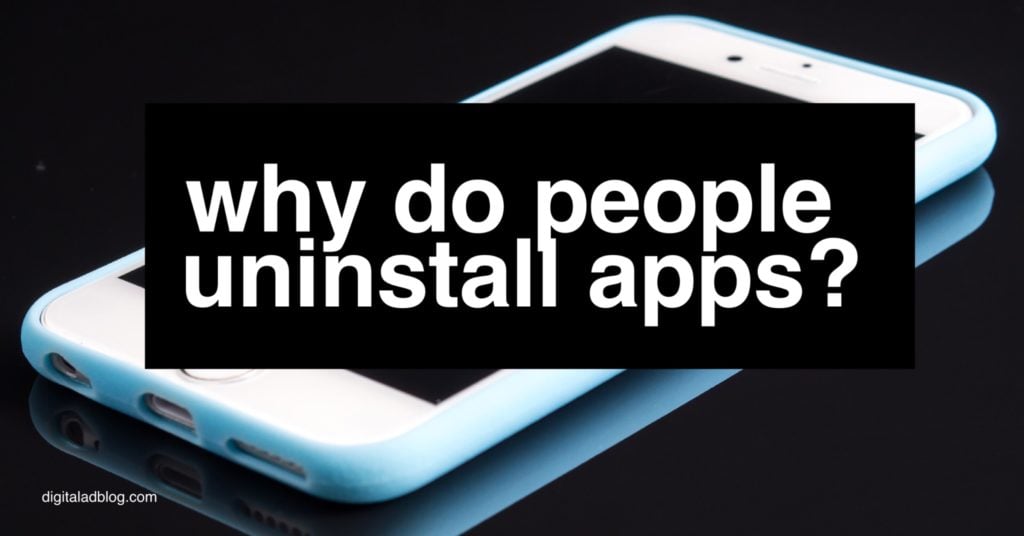Why do People Uninstall Apps?

ITR created an eye opening infographic explaining why people uninstall apps. There are current 1000’s apps being created and added to app stores every day. How long does a user actually keep an app for and what are their reasons for uninstalling?
See Also:
- State of App Security in 2016
- Mobile App Advertising for Beginners
- Mobile App Engagement Infographic

Infographic Summary Why People Uninstall Apps
Total Global Number of Apps in Leading Stores
Google Play – 1,600,000
Apple App Store 1,500,000
Amazon Appstore – 400,000
Windows Phone – 340,000
Blackberry World – 130,000
Most Popular Categories
Games – 21.8%
Business – 10.3%
Education – 9.8%
Why Apps Are Being Uninstalled?
Took up too much storage – 50.6%
Intrusive Advertising – 41.3%
Kept Freezing 33.8%
Privacy Concerns – 29.6%
Poor Design / didn’t understand how to use it – 26.8%
Users over the age of 55 stated intrusive advertising as the primary reason for deleting apps – 42%
Top 3 Reasons for Uninstalling gaming apps
1. Didn’t enjoy the game – 69.3%
2. Too many advertisements – 65.6%
3. Annoying notifications – 59.7%
Top 3 reasons for uninstalling business apps
1. Found a better quality app – 28.4%
2. Poor Use experience – 27%
3. You have to pay extra for the features you need – 24.6%
Top 3 Reasons for uninstalling education apps
1. Information is no longer of interest – 40.4%
2. Was not engaging enough – 34.2%
3. Found a better alternative – 22.2%
8 Most Common App Usability Design Mistakes:
1. Non-Standard GUI (graphical user interface) Controls – Non standard scrollbars which can cause users to overlook some of the options available on the app.Text and headlines that look like links causing users to try and tap non responsive text Adding elements which look like buttons but do not initiate an action.
2. Not Localized – Not localizing global apps for multiple languages. 50% of the countries within the top 10 for downloads and revenue are countries where English is not the first language. The user experience is therefore inferior or more challenging than that of a native English speaker.
3. Inconsistency – Using different words or commands for the same action or element like blog and newsroom. Using the same word for multiple concepts in different parts of the application like the business matrix and the business chart.
4. No default Values – Now using drop down menus can slow down interaction as users have to specify every value. Missing default values cause confusion over what type of answer is appropriate for the question asked.
5. Dumping users into the App – Not providing any set-up information to give users an idea of what’s going to happen or how to operate the app. Not offering users simple easy to read instructions can cause users to close the app as they will not spend time reading excessive information.
6. One size fits all approach – Designing for one particular screen size will limit the devices your app will work on. Not taking into account screen rotation will prohibit uses from using their preferred device holding position.
7. Tiny Click Targets – Users miss tiny click targets and click outside the active area which may cause users to believe that something isn’t actionable.
8. Overwhelming users – Too many features at the very beginning can give the perception of an over complicated and confusing app.
Apple Store vs. Google Play
Apple Store # of available apps 1.5 million with 100 billion downloads.
Google Play # of available apps 1.6 Million with 50 billion downloads.
Apple Store Advantages
More visibility than any other app marketplace
Developers get 70% of the sales of their app
The app review team provides clear information as to why an app has been rejected.
Apple Store Disadvantages
The process of getting an app approved is long
The submission regulations are very strict
The level of competition is very high
Google Play Advantages
The submission process is faster with fewer restrictions.
Once the app is live the developer can build in their own customer base
Low registration costs
Google Play Disadvantages
The platform is highly fragmented. Promoting an app can be costly.
Dosen’t provide much guidence making it difficult for inexperienced developers
Users generally prefer to download free apps over paid apps.